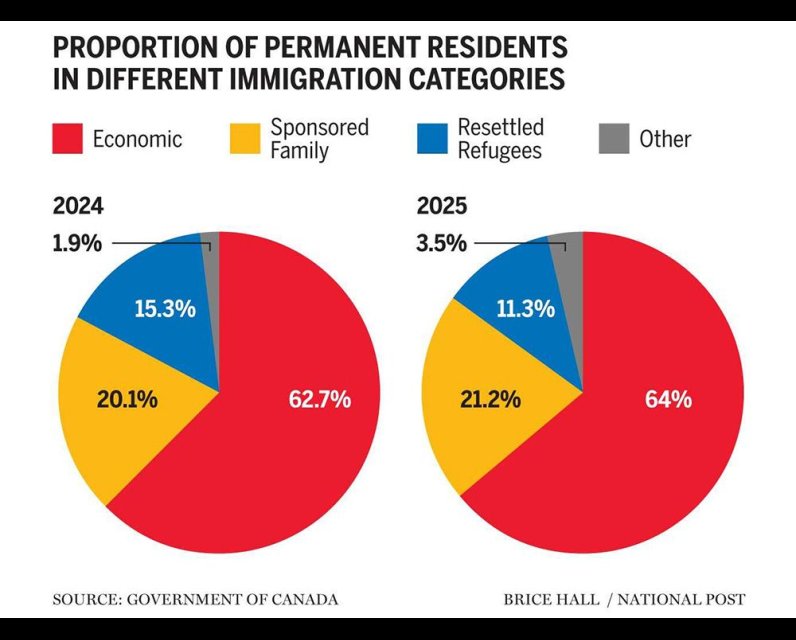Source Feed: National Post
Author: Tyler Dawson
Publication Date: May 24, 2025 - 07:30
What the data show about the state of immigration in Canada since cuts were announced
May 24, 2025

A new analysis of immigration data released by the federal government reveals that while the number of new permanent residents dropped after the federal government announced that it would cut immigration levels, the number of temporary foreign workers actually increased, while other temporary permits declined.
Last October, the federal government under then prime minister Justin Trudeau announced it would reduce its permanent immigration targets from 500,000 down to 395,000 in 2025. The government also set a cap for the first time on the intake of temporary residents in both student and worker streams, at 673,650 temporary resident visas for 2025.
“Meeting these targets is not simple given the need to account for regional priorities, pre-existing and other considerations,” says a
detailed analysis
of Immigration, Refugees and Citizenship Canada data done by the Metropolis Institute and the Association for Canadian Studies.
The government will also have to take into account population growth, which has slowed since the immigration cuts were announced. During the fourth quarter of 2024, Canada’s population grew by 0.2 per cent, the slowest quarterly growth rate since the end of 2020.
“Those declines in population growth, that’s an issue that is the object of an important national conversation that we’re not really having. We’re not meaningfully having that conversation, which is, do we want population growth? Or do we not? We’re very dependent on immigration in that regard, and so we’re not making that connection,” said Jack Jedwab, president and CEO of the Association for Canadian Studies and the Metropolis Institute. In a follow-up email, Jedwab noted that Prime Minister Mark Carney promised to return “our overall immigration rates to sustainable levels,” in his
mandate letter
published on May 21. But that is a term “that is open to much interpretation,” Jedwab said.
According to Statistics Canada data, the overall population reached 41,528,680 on Jan. 1, 2025, up from 41,465,298 on Oct. 1, 2024, an increase of 63,382, the report states. “By contrast, the population increase between the two previous quarters was 176,699. Immigration level reductions played a critical role in the outcome,” the report states.
<img src=”https://smartcdn.gprod.postmedia.digital/nationalpost/wp-content/uploads/2025/05/na0524-immigrationReport-01-BH-W.jpg” alt=”A chart shows permanent residents admitted by province” width=”1200″ height=”1720″ class=”alignnone size-full wp-image-80540974″ />
While the number of new permanent residents in a single quarter declined by 15 per cent, when comparing the first quarter of 2024 to the first quarter of 2025, the largest reduction in newcomers was attributed to temporary residents who came via the International Mobility Program (IMP). The program allows companies to hire temporary foreign workers without the usual Labour Market Impact Assessment. The IMP includes the post-graduate work permits granted to international students, the International Experience Canada stream for workers aged 18 to 35, free trade agreements, company transfers and permits for high-demand occupations, such as software engineers, among other programs.
Twenty-five per cent fewer people on IMP permits came to Canada in the first quarter of 2025 (176,805) compared to the first quarter of 2024 (230,405). There were 53,600 fewer IMP permits issued, but this can mostly be attributed to the fact that 45,610 fewer Ukrainians came to Canada in that period. In the first quarter of 2024, between Jan. 1 and March 31, 66,720 Ukrainians came to Canada on an IMP permit, compared to 21,110 in the first quarter of 2025.
The number of temporary foreign workers actually grew between the two quarters. In the first quarter of 2024, 42,730 permits were granted, compared to 44,675 in the first quarter of 2025.
<img src=”https://smartcdn.gprod.postmedia.digital/nationalpost/wp-content/uploads/2025/05/na0524-immigrationReport-02-BH-W.jpg” alt=”A chart shows the type of permanent immigrants and temporary migrants admitted into Canada” width=”1200″ height=”1710″ class=”alignnone size-full wp-image-80540973″ />
Only Quebec (with a five per cent decline) and Alberta (with a 12 per cent drop) saw the number of new temporary foreign workers decline.
Study permits declined by 20 per cent between the two periods, from 121,070 approved in the first quarter of 2024 to 96,015 in the first quarter of 2025. In Ontario, in the first quarter of 2024, there were 58,470 new study permit holders; in the first quarter of 2025, there were 44,185. While other provinces remained relatively stable — albeit on an entirely different order of magnitude than Ontario — British Columbia also saw a significant drop, from 27,735 new study permits to 18,850.
The largest declines in new study permit holders were seen among those from Hong Kong (a 40 per cent drop), Ghana (a 39 per cent drop) and India and Brazil (both saw a roughly 31 per cent drop).
<img src=”https://smartcdn.gprod.postmedia.digital/nationalpost/wp-content/uploads/2025/05/na0524-immigrationReport-04-BH-W.jpg” alt=”A chart shows the change in new study permits between 2024 and 2025″ width=”1200″ height=”1260″ class=”alignnone size-full wp-image-80540972″ />
The number of new permanent residents dropped across the country, when comparing the first quarter of 2024 and the first quarter of 2025. However, the effects ranged widely by province: Manitoba saw a five per cent decline in the number of permanent residents, while Prince Edward Island saw a 39 per cent drop. Nova Scotia and Quebec both saw a 29 per cent drop, New Brunswick a 19 per cent drop, Ontario an 11 per cent drop, Saskatchewan an 18 per cent drop, Alberta a 12 per cent drop and British Columbia a 16 per cent drop, while Newfoundland and Labrador actually saw a 12 per cent increase.
For the first time, Quebec’s share of new permanent residents in Canada dropped below 10 per cent of the total. In the first quarter of 2025, just nine per cent of them settled in Quebec. In comparison, Ontario took 45 per cent of new permanent residents while Atlantic Canada took eight per cent. Around nine per cent of new permanent residents went to Manitoba and Saskatchewan, while Alberta took 13 per cent and B.C. took 14 per cent.
The largest reduction among classes of new permanent residents was seen among refugees.
“When looking at what happened over the first quarter, by analyzing the data made available by (Immigration, Refugees and Citizenship Canada), is that the disproportionate cut in the reduction of numbers when comparing the first quarter of last year to the first quarter of this year was to refugees,” said Jedwab. “We do have an important humanitarian tradition in Canada, the government continues to reiterate that. And so those disproportionate cuts, we need to know what those disproportionate cuts in refugees imply for our humanitarian commitments.”
In the first quarter of 2024, around 15 per cent of new permanent residents in Canada were refugees; in the first quarter of 2025, just 11 per cent were. The proportions of other classes of newcomers remained fairly stable: almost 63 per cent of new permanent residents in the first quarter of 2024 were economic migrants, and in 2025, 65 per cent were. In 2024, 20 per cent of all new permanent residents came into the country via sponsored family resettlement, compared to 21 per cent in 2025.
When it comes to economic migrants, Ontario was the outlier. Between the first quarter of 2024 and 2025, Ontario experienced only a 1.5 per cent drop. Quebec saw a nearly 28 per cent drop and the Prairies saw a nearly 23 per cent drop.
However, Ontario saw a fairly significant decline in the number of refugees who were granted permanent residence (a 40 per cent drop). Quebec experienced a nearly 58 per cent drop. Newfoundland and Labrador had the most significant decline (72 per cent), while Manitoba saw a 27 per cent drop, B.C. a 37 per cent drop and Alberta a 7.5 per cent drop.
Newfoundland and Labrador was another outlier: While economic resettlement figures declined by 13 per cent across the country, the easternmost province actually gained 36 per cent more economic migrants in the first quarter of 2025, compared to the first quarter of 2024.
“There are going to be regional effects for those cuts,” said Jedwab. “They don’t all get implemented evenly across all the regions. That may be the theory, the idea may be to see those cuts distributed equally across regions. But, in practice, that isn’t what happens.”
<img src=”https://smartcdn.gprod.postmedia.digital/nationalpost/wp-content/uploads/2025/05/na0524-immigrationReport-05-BH-W.jpg” alt=”A chart shows the change in permanent residents by country of origin” width=”1200″ height=”2295″ class=”alignnone size-full wp-image-80540971″ />
Canada has also seen a major decline in the number of asylum claims made at the border. Canada saw a 75 per cent drop in asylum claims made at airports, from 13,400 to 3,340, between the first quarter of 2024 and the first quarter of 2025. There was a 10 per cent drop in claims at other borders, from 4,575 to 4,125, and a 24 per cent drop in those making claims at inland borders, from 28,135 to 21,415.
Claims dropped the most among people coming from Mexico (a 72 per cent drop) and Bangladesh (an 82 per cent drop)The most claims came from India, but those also saw a significant drop (22 per cent), from 6,760 to 5,260.
The only two countries that saw growth between the two quarters were Haiti (a 22 per cent increase) and Iran (a five per cent increase).
The data also show some shifting trends on country of origin for refugees who were granted permanent residence. Sixty-five per cent fewer Afghans became permanent residents in the first quarter of 2025, as did nearly 49 per cent fewer Iranians and 53 per cent fewer Syrians. However, several countries experienced growth, including Colombia (70 per cent), Ukraine (59 per cent) and Somalia (43 per cent).
Our website is the place for the latest breaking news, exclusive scoops, longreads and provocative commentary. Please bookmark nationalpost.com and sign up for our daily newsletter, Posted, here.
A B.C. wildfire that came within metres of homes and triggered a local state of emergency in Squamish is now being held.The BC Wildfire Service said late Saturday that the Dryden Creek wildfire, which ignited last Monday, is projected to remain within its current perimeter based on forest fuel, weather conditions and resource availability.
June 15, 2025 - 20:15 | Andrea Woo | The Globe and Mail
Prayers filled the air at the National Holocaust Monument in Ottawa Sunday at a vigil held one week after the solemn concrete memorial was defaced with the words 'feed me' — an apparent reference to threat of famine in Gaza.
June 15, 2025 - 19:51 | | CBC News - Ottawa
BANFF, Alta. — The heads of the world’s richest economies are converging on Alberta today for one of the most high-stakes G7 meetings in recent memory amid a U.S.-led global tariff war and the growing crisis in the Middle East.
On many of the G7’s key issues — namely the global trade war and Israel’s military operations in Gaza — Trump and the rest of the G7 leaders are largely on opposite sides.
Canadian Prime Minister Mark Carney’s job as chair of the summit in Kananaskis, Alta., is to mediate discussions to make sure the tense alliance doesn’t blow up.
And that job has never...
June 15, 2025 - 18:56 | Christopher Nardi | National Post



Comments
Be the first to comment